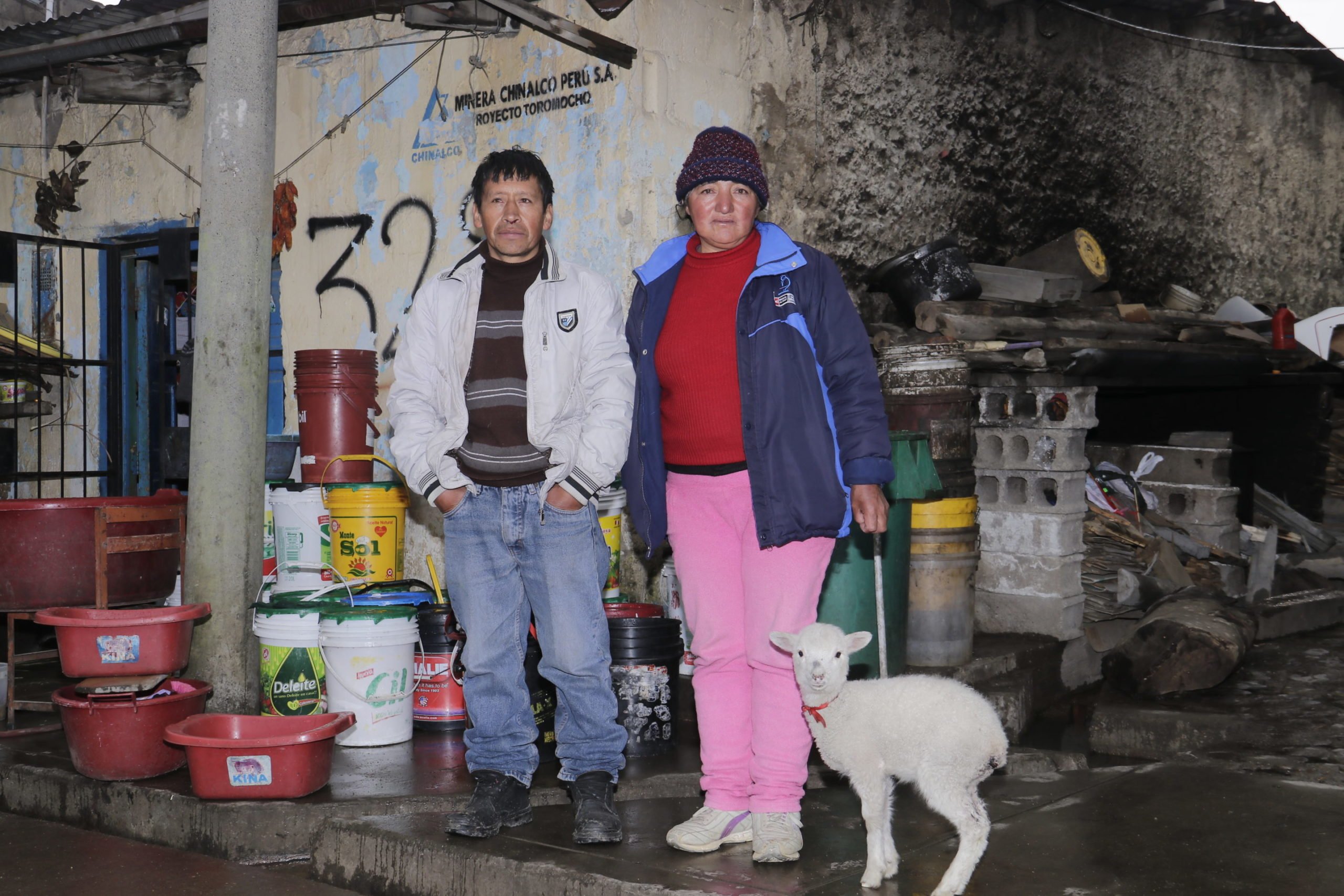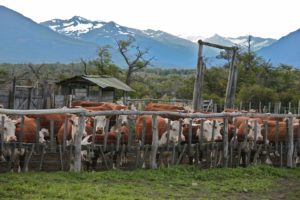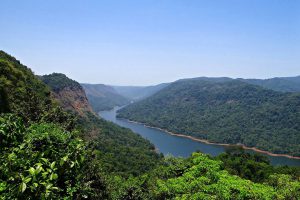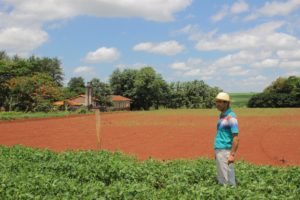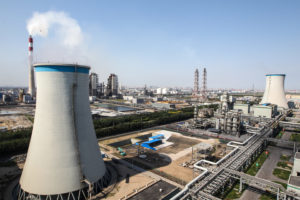Mining giant Chinalco, which operates the Toromocho Project in Peru, built a town to resettle the population of Morococha to enable the extraction of copper from beneath the ground where some 5,000 people once lived. Six years after the beginning of the move – once celebrated as a triumph in community relations – the new settlement has no economic future and is fast becoming a ghost town.
Diálogo Chino and Convoca.pe travelled to the area five hours from Lima, discovering that amidst the frustration of the resettled population, there is another social conflict. The last inhabitants of the old town have refused to relocate and are being dispossessed of their land. They find themselves in an increasingly precarious situation.
In the chilly mountains of Peru’s central highlands, more than 4,700 metres above sea level, the demands of the last inhabitants of Old Morococha – 65 families who resist resettlement – hang frozen in the air. For the past six years, they have been living with the tremors, dust and noise of detonations at the Toromocho mine, operated by Chinese company Chinalco, which has invested US$4.476 billion in the megaproject.
Heavy machinery has now almost completely razed all buildings in the village. The rubble makes it resemble a war zone. In this area of Peru, prone to natural disasters, the world’s second largest producer of copper, Chinalco wants to create an open-pit to exploit minerals beneath Morococha. Until 2012, it was home to more than 5,000 residents. 96% have left the site. Several more have settled in a new town built by Chinalco some 12 kilometres away.
In Old Morococha, those remaining live in difficult conditions, themselves protagonists in an ongoing social conflict. The mine, 160 kilometres from the capital Lima and one of Peru’s largest copper projects, is slated for a US$1.355 billion expansion.
“It is sad to live here. There is no business here. There is nothing,” Feliza Alania, one of the last inhabitants of the old town, says tearfully from her gloomy grocery store. She says she used to sell an average of US$45 in goods each day. Now, only her own family consumes what’s left on the dusty shelves.

Chinalco has tried to negotiate a deal with the remaining residents, who are adamant they won’t accept the same conditions the transnational company offered their former neighbours. “They have offered us crumbs, I tell you,” said Máximo Díaz, a carpenter and Alania’s husband. Díaz is also the President of the Broad Front for the Defense and Development of the Interests of Morococha (FADDIM), a collective founded following the resettlement process.
The company did not recognise the residents’ right of land ownership at the time of their purchase offer, according to Noé Gamarra, a representative of displaced former property owners. He explains; “Chinalco has only given quotes for the value of the erected buildings, but not for the land.” Under this criteria, he says, market prices average between US$60 and US$100 per square metre. Yet this does not take into account minerals in the subsoil, especially copper. Extracting it could increase the mine’s daily output from 117,000 to 172,000 metric tonnes.
Chinalco expects to reach this capacity by 2020 when the expansion of the Toromocho Project, which the Ministry of Energy and Mines of Peru approved on March 23 this year, is complete. That same day, then vice-president Martín Vizcarra assumed the Peruvian presidency in the midst of a deep political crisis that led Pedro Pablo Kuczynski to resign.
In June, in the presence of Vizcarra himself, Chinalco announced the beginning of expansion works. “When investment represents progress and development, the State becomes an ally in that investment,” the President said. After the expansion, the project is expected to generate US$2 billion annually.
However, the company will only meet this target with no one on the land the mining giant wants.
“If they do not reach [an agreement] with me, they must let me live in peace,” says Díaz defiantly. “The blasts from the mine shake like an earthquake and twice the roof of my workshop has been damaged [by falling rocks],” he says. Such occurrences are commonplace.
“The police surround us every day. They watch, and whatever you do they are all around you. Sometimes, there are shots [explosions]. They take all of us outside,” laments Feliza Alania helplessly. “They have us controlled down to the last millimetre,” adds Díaz. This is no exaggeration. The Diálogo Chino and Convoca.pe team was followed by private surveillance around Old Morococha. They requested identification and enquired about our activities.
Trust has eroded between the population, law enforcement and the authorities. Elvis Atachahua, a resident of Morococha, claims police officers travel in vehicles contracted by the mining company and support Chinalco’s demolitions which, he says, don’t have municipal authorisation. In the past, the Special Operations Division of the National Police and the Chinese state-owned company had an agreement acknowledging the company’s privileges. Inhabitants seem unequal before the law in Old Morococha.
For its part, Chinalco has, with some success, presented itself to the world as a company with a strong sense of social responsibility. No wonder, Toromocho is very important for the Aluminum Corporation of China, Chinalco’s parent company, given the enormous copper deposits and the amount of the rusty red metal China demands. The mine’s reserves are estimated at 1,526 million tonnes. In the first half of 2018, Peruvian copper exports were worth US$7,696 million, according to the National Society of Mining and Petroleum. 61% of shipments of this metal were China-bound.
“As everyone knows, copper minerals are scarce in China,” Huang Shanfu, then President of Chinalco in Peru said in an interview with Chinese state-run station CCTV on 13 November 2016. “As this project [Toromocho] gets underway, a solid basis for guaranteeing China’s copper resources will gradually be consolidated,” he stated. Other Chinese media, such as Sina News Finance this year questioned the economic wisdom of expanding the mine in the face of falling ore prices and company losses. News bulletins about Toromocho on Chinalco’s website have not been updated since 2013.
Huang insisted the needs of the people of Morococha would be a priority: “We consider it necessary to show the sense of responsibility of our company and to achieve a synergistic development between the economy and the local communities, in line with our motto: first contribute to the development of the local communities, then think about bringing the project to fruition.”
However, residents’ anger towards the company is palpable. “[Do you know] how many times they have tried to get me out of my house!” Edelmira Artica, whose residence has Chinalco’s logo stamped on the front, says heatedly. “Their guards know what time we enter and what time we leave (…) Even Chinalaco’s lawyer has said: ‘You have already lost your house down there [in the new city]; you have no right to anything’. I cannot eat my house – what we want is work! With work, I can do better than that house. But all the work avenues are closed off,” he laments.
In Morococha, if you are ‘lucky’ enough to have a job, you have to protect it. “From the day Chinalco arrived, all work is subject to conditions. Once [the term of] your contract is complete, they no longer wish to renew it,” says Rolando Jerónimo, another resident.
Unlike many conflicts where communities reject mining, Morococha has lived alongside extractive activities for centuries, and with large-scale operations for almost 80 years. Given this situation, it is incumbent on the company, the State – as a facilitator – and the population to find a satisfactory solution, including another option for relocation. Only then can residents resettle and generate economic activity.
The area on offer, however, is unappealing.
The new town
Twenty minutes from the devastated village, in the same district of Morococha, Chinalco has built a new town of small dwellings, each a 54 square-metre pavilion-like structure sat in uninterrupted lines.
Resettlement began in October 2012. New Morococha was supposed to house more than 1,200 families from the old town.
A 2011 Ministry of Housing report warned that the area selected was not the most suitable owing to a number of risk factors, including soil subsidence due to humidity, floods and earthquakes. The area lies between two lagoons that could overflow in the event of unexpected earth movements, the government said.
Before the move, the company promised improvements. Now 87% of the district’s homes are made of cement and brick (rather than mud). Access to basic services has increased dramatically. 93% of homes now have running water and 95% have electricity, according to the National Institute of Statistics and Informatics (INEI)’s 2017 census.
Tidy, yet small, empty and inert, New Morococha looks more like a toy town.
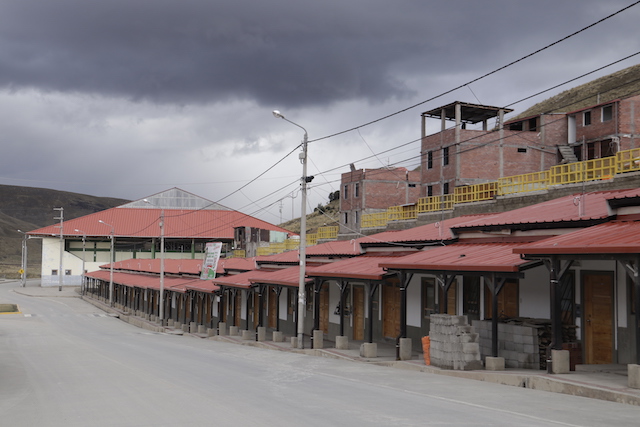
The new town built by Chinese mining giant Chinalco. Photo: Marco Alegre/Convoca
“Sometimes you see more dogs than people,” says resident Karla Victoria, also president of the new town’s Merchants’ Association. “Look at the street. There is dead silence. That’s how it is every day.”
José de Echave, an economist and former Peruvian vice-minister of environment says; “The big problem is that this new city has not yet consolidated itself into an adequate living space. People are far away from the economic hub of the area, very far from [other] economic opportunities.”
This lack of activity worries local traders. Yet it simply reflects residents’ low consumption and low incomes. Victoria had three restaurants before being resettled. Today, she has one: “We were told that the quality of life was going to be much better. They never told us things were going to get worse.”
According to a 2018 study by the Peruvian National University of the Centre (UNPC), 80.6% of the inhabitants of New Morococha think that their economic situation was better in the old city. 76.2% believe trade has dropped.
In 2013, the National Health Institute surveyed those still living in Old Morococha after the resettlement. They found that 52% of residents agreed to move, though 76% said that they were not part of talks when the measure was decided in 2006.
“It cannot be said that resettlement is complete. All the established guidelines were never fulfilled. A central issue was the economic viability of the city,” says Javier Jahncke, a lawyer who partnered the community in negotiations with Chinalco through the NGO Muqui Network.
The Environmental Impact Assessment (EIA) of the Toromocho project prepared for Chinalco and published in 2009, stated that “the camp […] operation would be part of the new city of Morococha.” Six years after relocation, it remains a promise.
“They constructed a building, but there is not one worker there,” Jahncke says.
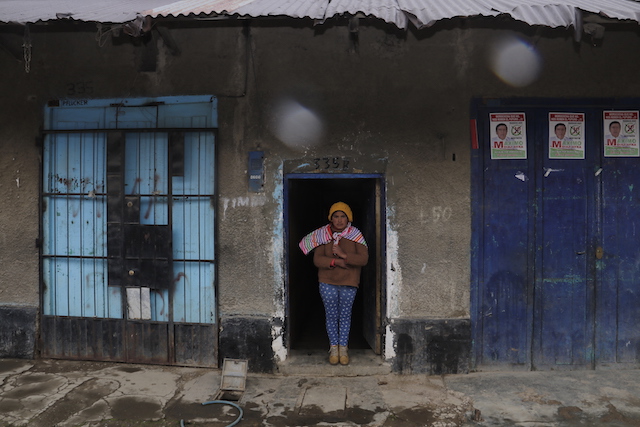
“Speaking objectively on resettlement, Chinalco was in constant dialogue with local authorities and offered concessions, but with such a large project, it is difficult not to have some outstanding issues,” a person familiar with the case told China’s 21st Century Business Herald. Homes whose residents refuse to leave because of extractive projects are known in Chinese as ‘nail-houses’ [‘ding zi fu’], an allusion to them sat resolutely atop a thin column as earth is excavated around them.
In Old Morococha, the reality was very different. Employees and subcontractors of the Volcan, Argentum and Austria-Duvaz mining companies lived in nearby camps and frequently visited the locality. “The economic dynamism that the workers of these companies generated in the [old] town with their local purchases and in providing employment [for] micro- and small businesses, will not be altered by the development of the Toromocho Project”, Chinalco’s impact study claimed.
The new city, however, is at a critical juncture. Karla Victoria warns that commerce depends almost exclusively on Chinalco which, she says, has a concessionaire selling products and food in its own camp, discouraging consumption in the city.
As traders’ representative, Victoria relays complaints to Chinalco. She claims workers subcontracted by the mining company have told her: “Madam, we’re not going to eat from you anymore. They have told us not to consume your goods. Reasons? I don’t know and I can’t give you any more details, but they have told us to go to so and so”.
“So and so is someone who never complains,” she says. Economic dependence has seemingly silenced some traders and job seekers.
“What we want is to do things freely, without fear of being ‘marked’ tomorrow, or being afraid that they will not buy from us,” Victoria claims. “For that, we have to be surrounded, as we were before, by more mining companies. If not, each business will be extinguished like a candle, as is happening,” she adds.
The city’s new market tells the story. At 10am on a Friday morning, the corridors are dark and covered with dirt. There are no customers or traders in the vast majority of the one hundred stalls. The only activity revolves around ten units close to the main gate. “It’s like it were a holiday”, several villagers say.

Unemployment impacts income and consumption. The mining company pledged in their impact study to “provide equal employment opportunities for both men and women as long as they meet the necessary training requirements to work in the [Toromocho] Project”.
Many of those now leaving the new town are women. In 2007, Morococha had 5,397 inhabitants; 3,176 male and 2,122 female, according to that year’s census. Ten years later, official statistics show that of the town’s 5,155 inhabitants, there are 3,486 men and only 1,669 women.
In 2017, unemployment reached 52% of the population, according to a UNCP survey of 294 homes in the new city. The lack of stable employment means inhabitants of Old Morococha still oppose the move.
César Reyna, a former advisor to Morococha’s municipal authority for the resettlement process, believes it was a mistake for affected residents to accept the sale of their homes to Chinalco. First, they should have closed negotiations on the conditions of relocation and the viability of the new town.
The process worked “backwards”, he claims. With land titles already transferred, the community couldn’t pressure the company to comply with its commitments. Roundtable negotiations involving the affected population, the authorities and the mining company, began in 2008. They have not yet reached a definitive agreement with the Old Morocochans.
Without clear terms, the new district capital has little future. Residents fear New Morococha will become a ghost town.
“It is an extreme situation, where the organisation and the social fabric have been eroded. There is no will to participate in the negotiation processes. There is an environmental problem with a tailings pond [the Huascocha lagoon, which holds toxic waste] and the economy does not work because the company did not fulfill its obligations,” Javier Jahncke says.
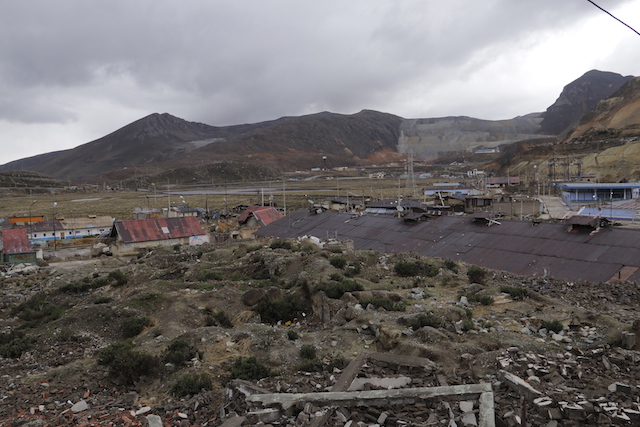
Worse, there are emerging signs of contamination from the mine. In April this year, the Ministry of Health diagnosed 27 children under the age of 12 years with lead poisoning.
Nor is it the first time. In 2014, Chinalco was cited by the Environmental Assessment and Control Agency (OEFA) for water misuse and had to temporarily suspend mining operations. In an interview with economic journal 21st Century Business Herald at the time, company executives argued that the company was “committed to strictly adhering to all regulations and local supervision, having immediately halted its mining activities, and was contracting a scientific evaluation and taking all measures to restart activities as soon as possible”.
Recently, the Peruvian State slashed funds for Morococha district. The 2017 budget earmarked only US$1.5 per capita for environmental issues, US$0.7 for economic matters, US$8 for social issues and US$160 for ‘institutional matters’, according to a report by the Peruvian Government’s National Strategic Planning Centre.
The land, copper and the law
At approximately 6am on the morning on September 7 this year, members of the Special Operations Division of the National Police arrived in Old Morococha in an unmarked white minibus. Equipped with shields, helmets and rifles, they surrounded the dilapidated municipal building, previously a shelter for the elderly. Chinalco workers leaned ladders against the walls and began demolishing the structure with sledge-hammers.
Residents demanded to see authorisation for the demolition, but were repelled by police. Following the incident, a company lawyer named 17 in a complaint of alleged disturbances, as Public Prosecutor’s documents seen by Convoca.pe show. They include an 80-year old woman. The municipality, in turn, also filed a complaint against the company for ‘aggravated usurpation’ and damage to a public structure.
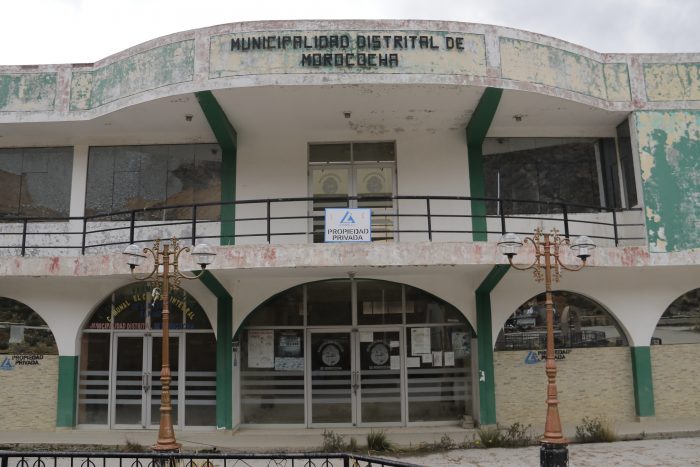
The shelter is a small part of an extensive 34-hectare piece of land that has been the site of a dispute between the community and Chinalco.
Until February this year, the extensive landholding was the property of the municipal district of Morococha, which, since 2003, had promised to use it to issue titles to local landowners. However, all 34 hectares are now in Chinalco’s name thanks to a series of swift actions taken by Peruvian authorities.
“This has been very quick,” says Elvis Fuster, vice-president of the Front for the Defense and Development of the Interests of Morococha. He says bureaucratic manoeuvers that caused locals to lose land coincided with the months prior to the fall of former president Pedro Pablo Kuczynski.
Only two regulations were necessary for the change of ownership to take place.
The first, published in November 2017, was a decree expediting expropriations. Ostensibly a preventative measure to limit the human cost of natural disasters, it made land ownership illegal in high-risk areas. Peru’s Congress approved the regulation as it rebuilt after the devastation caused by the El Niño Costero climate phenomenon. That year it caused 162 deaths from rains and floods and affected a total of 1.3 million people and 373,000 homes, according to a report by the National Civil Defense Institute.
Therefore, forbidding land ownership in high-risk areas could affect the legal status of any home in Old Morococha. The local government decided that the National Superintendency of Assets (SBN) should become custodian of such land.
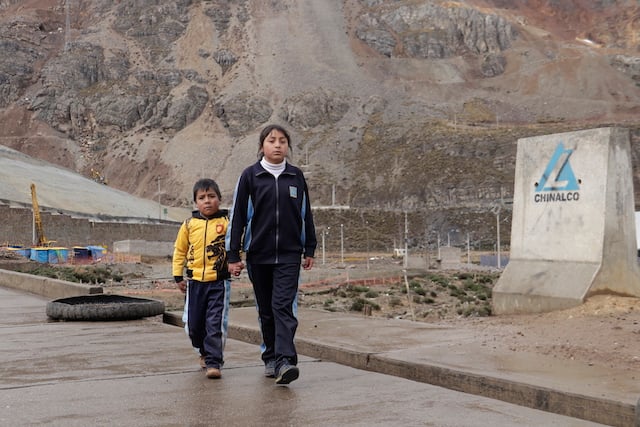
The second regulation excludes owners from having a say in expropriations deemed necessary for their own safety. The Government ordered a “declaration of intangibility”, that basically declares all housing in hazardous areas uninhabitable. The latter provision entered into force on January 10 this year.
These dates are key to understanding the speed of the legal process in Morococha.
One day before the regulation entered into force, the Peruvian Ministry of Energy and Mines’ approved the appointment of Ricardo Labó Fossa, then vice-minister of mines, as President of AMSAC [SAC Mining Assets], a Peruvian State company dedicated to the supervision of mining projects and environmental remediation. On January 17, Labó took up his seat on the Board. A day later, AMSAC’s general management requested the aforementioned “declaration of intangibility” of the 34 hectares of Old Morococha.
Labó, an economist, has a long experience in the mining sector, having worked from 2006 to 2014 at mining company Río Tinto. The Anglo-Australian corporation operates the La Granja copper project in the northern Peruvian department of Cajamarca.
Río Tinto has the Aluminum Corporation of China, owner of Chinalco, listed among its shareholders. According to its latest corporate annual report (2017), the Aluminum Corporation of China controls 10.32% of voting power in the Río Tinto Group through its offshore Shining Prospect Pte. Ltd., headquartered in Singapore. Since 2009, it has participated in the corporation through capital investment. That is to say, at the same time Labó provided services to the company.
Since October 26, we repeatedly insisted on an interview with representatives of Chinalco Peru Mining Company, S.A., contacting them via telephone and e-mail, and reiterating requests with the press office. We left messages for Álvaro Barrenechea Chávez, corporate affairs manager and an official spokesperson, and sent a letter to the company’s offices in Lima with our questions. We also tried contacting former vice minister Labó by telephone, e-mail (including to his personal account) and via social networks. At the time of publication, we had received no response from the company or the former official.
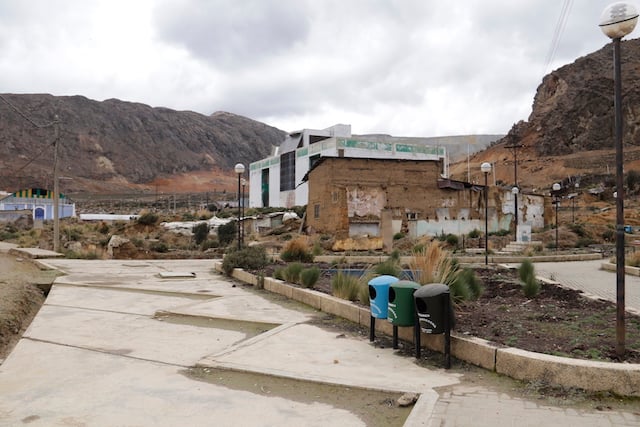
All the while, conflict simmers in Morococha.
“When it was said that Chinalco would be coming, [we believed] the times of the Cerro de Pasco Copper [Corporation] would return. People were happy, even ecstatic! The big doors were thrown open for them! We didn’t know this was going to happen,” says Máximo Díaz, the 66-year old carpenter who has seen Morococha grow over time thanks to the mineral that the town shields beneath its surface.
Today, however, the Toromocho megaproject – the largest investment in its the town’s history – threatens the survival of his Díaz’s community. Yet he stands firm in calling for investments to be responsibly managed: “We are not against mining in any way. One hundred percent of us count on it.” Díaz and other former residents will continue to demand conditions they consider fair.
“Nothing is impossible for us. We are enforcing our rights, nothing more than that.”
